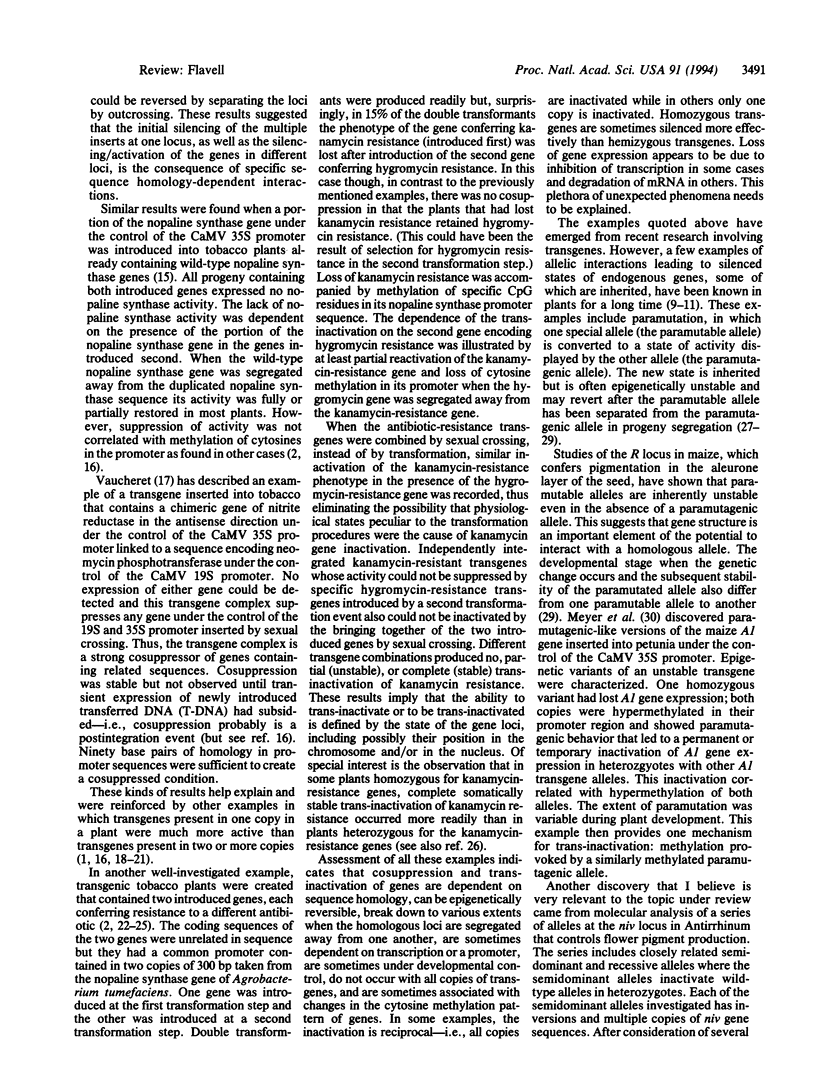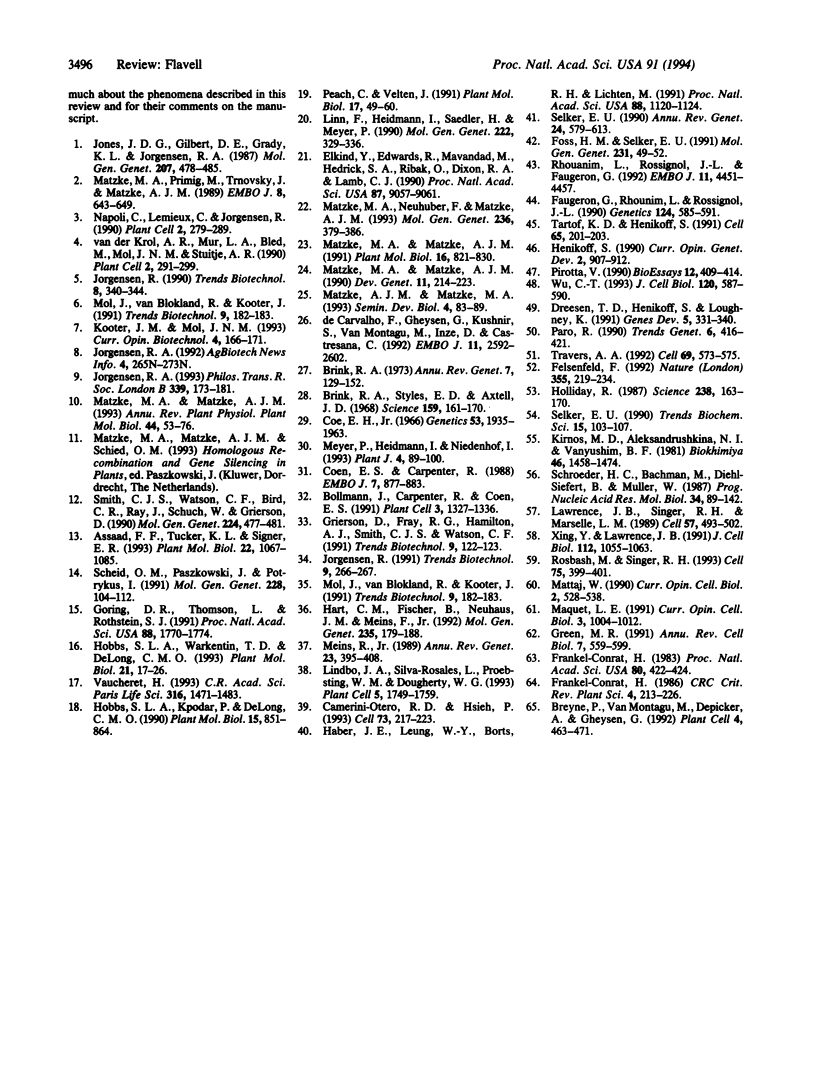Abstract
Numerous examples now exist in plants where the insertion of multiple copies of a transgene leads to loss of expression of some or all copies of the transgene. Where the transgene contains sequences homologous to an endogenous gene, expression of both transgene and endogenous gene is sometimes found to be impaired. Several examples of these phenomena displaying different features are reviewed. Possible explanations for the observed phenomena are outlined, drawing on known cellular processes in Drosophila, fungi, and mammals as well as plants. It is hypothesized that duplicated sequences can, under certain circumstances, become involved in cycles of hybrid chromatin formation or other processes that generate the potential for modification of inherited chromatin structure and cytosine methylation patterns. These epigenetic changes could lead to altered transcription rates or altered efficiencies of mRNA maturation and export from the nucleus. Where the loss of gene expression is posttranscriptional, antisense RNA could be formed on accumulated, inefficiently processed RNAs by an RNA-dependent RNA polymerase or from a chromosomal promoter and cause the observed loss of homologous mRNAs and possibly the modification of homologous genes. It is suggested that the mechanisms evolved to help silence the many copies of transposable elements in plants. Multicopy genes that are part of the normal gene catalog of a plant species must have evolved to avoid these silencing mechanisms or their consequences.
Full text
PDF






Selected References
These references are in PubMed. This may not be the complete list of references from this article.
- Assaad F. F., Tucker K. L., Signer E. R. Epigenetic repeat-induced gene silencing (RIGS) in Arabidopsis. Plant Mol Biol. 1993 Sep;22(6):1067–1085. doi: 10.1007/BF00028978. [DOI] [PubMed] [Google Scholar]
- Bollmann J., Carpenter R., Coen E. S. Allelic interactions at the nivea locus of Antirrhinum. Plant Cell. 1991 Dec;3(12):1327–1336. doi: 10.1105/tpc.3.12.1327. [DOI] [PMC free article] [PubMed] [Google Scholar]
- Breyne P., van Montagu M., Depicker N., Gheysen G. Characterization of a plant scaffold attachment region in a DNA fragment that normalizes transgene expression in tobacco. Plant Cell. 1992 Apr;4(4):463–471. doi: 10.1105/tpc.4.4.463. [DOI] [PMC free article] [PubMed] [Google Scholar]
- Brink R. A. Paramutation. Annu Rev Genet. 1973;7:129–152. doi: 10.1146/annurev.ge.07.120173.001021. [DOI] [PubMed] [Google Scholar]
- Brink R. A., Styles E. D., Axtell J. D. Paramutation: directed genetic change. Paramutation occurs in somatic cells and heritably alters the functional state of a locus. Science. 1968 Jan 12;159(3811):161–170. doi: 10.1126/science.159.3811.161. [DOI] [PubMed] [Google Scholar]
- Camerini-Otero R. D., Hsieh P. Parallel DNA triplexes, homologous recombination, and other homology-dependent DNA interactions. Cell. 1993 Apr 23;73(2):217–223. doi: 10.1016/0092-8674(93)90224-e. [DOI] [PubMed] [Google Scholar]
- Coen E. S., Carpenter R. A semi-dominant allele, niv-525, acts in trans to inhibit expression of its wild-type homologue in Antirrhinum majus. EMBO J. 1988 Apr;7(4):877–883. doi: 10.1002/j.1460-2075.1988.tb02891.x. [DOI] [PMC free article] [PubMed] [Google Scholar]
- Dreesen T. D., Henikoff S., Loughney K. A pairing-sensitive element that mediates trans-inactivation is associated with the Drosophila brown gene. Genes Dev. 1991 Mar;5(3):331–340. doi: 10.1101/gad.5.3.331. [DOI] [PubMed] [Google Scholar]
- Elkind Y., Edwards R., Mavandad M., Hedrick S. A., Ribak O., Dixon R. A., Lamb C. J. Abnormal plant development and down-regulation of phenylpropanoid biosynthesis in transgenic tobacco containing a heterologous phenylalanine ammonia-lyase gene. Proc Natl Acad Sci U S A. 1990 Nov;87(22):9057–9061. doi: 10.1073/pnas.87.22.9057. [DOI] [PMC free article] [PubMed] [Google Scholar]
- Faugeron G., Rhounim L., Rossignol J. L. How does the cell count the number of ectopic copies of a gene in the premeiotic inactivation process acting in Ascobolus immersus? Genetics. 1990 Mar;124(3):585–591. doi: 10.1093/genetics/124.3.585. [DOI] [PMC free article] [PubMed] [Google Scholar]
- Felsenfeld G. Chromatin as an essential part of the transcriptional mechanism. Nature. 1992 Jan 16;355(6357):219–224. doi: 10.1038/355219a0. [DOI] [PubMed] [Google Scholar]
- Foss H. M., Selker E. U. Efficient DNA pairing in a Neurospora mutant defective in chromosome pairing. Mol Gen Genet. 1991 Dec;231(1):49–52. doi: 10.1007/BF00293820. [DOI] [PubMed] [Google Scholar]
- Fraenkel-Conrat H. RNA-dependent RNA polymerases of plants. Proc Natl Acad Sci U S A. 1983 Jan;80(2):422–424. doi: 10.1073/pnas.80.2.422. [DOI] [PMC free article] [PubMed] [Google Scholar]
- Goring D. R., Thomson L., Rothstein S. J. Transformation of a partial nopaline synthase gene into tobacco suppresses the expression of a resident wild-type gene. Proc Natl Acad Sci U S A. 1991 Mar 1;88(5):1770–1774. doi: 10.1073/pnas.88.5.1770. [DOI] [PMC free article] [PubMed] [Google Scholar]
- Green M. R. Biochemical mechanisms of constitutive and regulated pre-mRNA splicing. Annu Rev Cell Biol. 1991;7:559–599. doi: 10.1146/annurev.cb.07.110191.003015. [DOI] [PubMed] [Google Scholar]
- Haber J. E., Leung W. Y., Borts R. H., Lichten M. The frequency of meiotic recombination in yeast is independent of the number and position of homologous donor sequences: implications for chromosome pairing. Proc Natl Acad Sci U S A. 1991 Feb 15;88(4):1120–1124. doi: 10.1073/pnas.88.4.1120. [DOI] [PMC free article] [PubMed] [Google Scholar]
- Hart C. M., Fischer B., Neuhaus J. M., Meins F., Jr Regulated inactivation of homologous gene expression in transgenic Nicotiana sylvestris plants containing a defense-related tobacco chitinase gene. Mol Gen Genet. 1992 Nov;235(2-3):179–188. doi: 10.1007/BF00279359. [DOI] [PubMed] [Google Scholar]
- Henikoff S. Position effect and related phenomena. Curr Opin Genet Dev. 1992 Dec;2(6):907–912. doi: 10.1016/s0959-437x(05)80114-5. [DOI] [PubMed] [Google Scholar]
- Hobbs S. L., Kpodar P., DeLong C. M. The effect of T-DNA copy number, position and methylation on reporter gene expression in tobacco transformants. Plant Mol Biol. 1990 Dec;15(6):851–864. doi: 10.1007/BF00039425. [DOI] [PubMed] [Google Scholar]
- Hobbs S. L., Warkentin T. D., DeLong C. M. Transgene copy number can be positively or negatively associated with transgene expression. Plant Mol Biol. 1993 Jan;21(1):17–26. doi: 10.1007/BF00039614. [DOI] [PubMed] [Google Scholar]
- Holliday R. The inheritance of epigenetic defects. Science. 1987 Oct 9;238(4824):163–170. doi: 10.1126/science.3310230. [DOI] [PubMed] [Google Scholar]
- Jorgensen R. Altered gene expression in plants due to trans interactions between homologous genes. Trends Biotechnol. 1990 Dec;8(12):340–344. doi: 10.1016/0167-7799(90)90220-r. [DOI] [PubMed] [Google Scholar]
- Kirnos M. D., Aleksandrushkina N. I., Vaniushin B. F. 5-Metiltsitozin v pirimidinovykh posledovatel'nostiakh DNK rastenii i zhivotnykh: spetsifichnost' metilirovaniia. Biokhimiia. 1981 Aug;46(8):1458–1474. [PubMed] [Google Scholar]
- Lawrence J. B., Singer R. H., Marselle L. M. Highly localized tracks of specific transcripts within interphase nuclei visualized by in situ hybridization. Cell. 1989 May 5;57(3):493–502. doi: 10.1016/0092-8674(89)90924-0. [DOI] [PubMed] [Google Scholar]
- Lindbo J. A., Silva-Rosales L., Proebsting W. M., Dougherty W. G. Induction of a Highly Specific Antiviral State in Transgenic Plants: Implications for Regulation of Gene Expression and Virus Resistance. Plant Cell. 1993 Dec;5(12):1749–1759. doi: 10.1105/tpc.5.12.1749. [DOI] [PMC free article] [PubMed] [Google Scholar]
- Linn F., Heidmann I., Saedler H., Meyer P. Epigenetic changes in the expression of the maize A1 gene in Petunia hybrida: role of numbers of integrated gene copies and state of methylation. Mol Gen Genet. 1990 Jul;222(2-3):329–336. doi: 10.1007/BF00633837. [DOI] [PubMed] [Google Scholar]
- Maquat L. E. Nuclear mRNA export. Curr Opin Cell Biol. 1991 Dec;3(6):1004–1012. doi: 10.1016/0955-0674(91)90121-e. [DOI] [PubMed] [Google Scholar]
- Mattaj I. W. Splicing stories and poly(A) tales: an update on RNA processing and transport. Curr Opin Cell Biol. 1990 Jun;2(3):528–538. doi: 10.1016/0955-0674(90)90138-5. [DOI] [PubMed] [Google Scholar]
- Matzke M. A., Matzke A. J. Differential inactivation and methylation of a transgene in plants by two suppressor loci containing homologous sequences. Plant Mol Biol. 1991 May;16(5):821–830. doi: 10.1007/BF00015074. [DOI] [PubMed] [Google Scholar]
- Matzke M. A., Neuhuber F., Matzke A. J. A variety of epistatic interactions can occur between partially homologous transgene loci brought together by sexual crossing. Mol Gen Genet. 1993 Jan;236(2-3):379–386. doi: 10.1007/BF00277137. [DOI] [PubMed] [Google Scholar]
- Matzke M. A., Primig M., Trnovsky J., Matzke A. J. Reversible methylation and inactivation of marker genes in sequentially transformed tobacco plants. EMBO J. 1989 Mar;8(3):643–649. doi: 10.1002/j.1460-2075.1989.tb03421.x. [DOI] [PMC free article] [PubMed] [Google Scholar]
- Meins F., Jr Habituation: heritable variation in the requirement of cultured plant cells for hormones. Annu Rev Genet. 1989;23:395–408. doi: 10.1146/annurev.ge.23.120189.002143. [DOI] [PubMed] [Google Scholar]
- Meyer P., Heidmann I., Niedenhof I. Differences in DNA-methylation are associated with a paramutation phenomenon in transgenic petunia. Plant J. 1993 Jul;4(1):89–100. doi: 10.1046/j.1365-313x.1993.04010089.x. [DOI] [PubMed] [Google Scholar]
- Mittelsten Scheid O., Paszkowski J., Potrykus I. Reversible inactivation of a transgene in Arabidopsis thaliana. Mol Gen Genet. 1991 Aug;228(1-2):104–112. doi: 10.1007/BF00282454. [DOI] [PubMed] [Google Scholar]
- Napoli C., Lemieux C., Jorgensen R. Introduction of a Chimeric Chalcone Synthase Gene into Petunia Results in Reversible Co-Suppression of Homologous Genes in trans. Plant Cell. 1990 Apr;2(4):279–289. doi: 10.1105/tpc.2.4.279. [DOI] [PMC free article] [PubMed] [Google Scholar]
- Paro R. Imprinting a determined state into the chromatin of Drosophila. Trends Genet. 1990 Dec;6(12):416–421. doi: 10.1016/0168-9525(90)90303-n. [DOI] [PubMed] [Google Scholar]
- Peach C., Velten J. Transgene expression variability (position effect) of CAT and GUS reporter genes driven by linked divergent T-DNA promoters. Plant Mol Biol. 1991 Jul;17(1):49–60. doi: 10.1007/BF00036805. [DOI] [PubMed] [Google Scholar]
- Pirrotta V. Transvection and long-distance gene regulation. Bioessays. 1990 Sep;12(9):409–414. doi: 10.1002/bies.950120903. [DOI] [PubMed] [Google Scholar]
- Rhounim L., Rossignol J. L., Faugeron G. Epimutation of repeated genes in Ascobolus immersus. EMBO J. 1992 Dec;11(12):4451–4457. doi: 10.1002/j.1460-2075.1992.tb05546.x. [DOI] [PMC free article] [PubMed] [Google Scholar]
- Rosbash M., Singer R. H. RNA travel: tracks from DNA to cytoplasm. Cell. 1993 Nov 5;75(3):399–401. doi: 10.1016/0092-8674(93)90373-x. [DOI] [PubMed] [Google Scholar]
- Schröder H. C., Bachmann M., Diehl-Seifert B., Müller W. E. Transport of mRNA from nucleus to cytoplasm. Prog Nucleic Acid Res Mol Biol. 1987;34:89–142. doi: 10.1016/s0079-6603(08)60494-8. [DOI] [PubMed] [Google Scholar]
- Selker E. U. DNA methylation and chromatin structure: a view from below. Trends Biochem Sci. 1990 Mar;15(3):103–107. doi: 10.1016/0968-0004(90)90193-f. [DOI] [PubMed] [Google Scholar]
- Selker E. U. Premeiotic instability of repeated sequences in Neurospora crassa. Annu Rev Genet. 1990;24:579–613. doi: 10.1146/annurev.ge.24.120190.003051. [DOI] [PubMed] [Google Scholar]
- Smith C. J., Watson C. F., Bird C. R., Ray J., Schuch W., Grierson D. Expression of a truncated tomato polygalacturonase gene inhibits expression of the endogenous gene in transgenic plants. Mol Gen Genet. 1990 Dec;224(3):477–481. doi: 10.1007/BF00262443. [DOI] [PubMed] [Google Scholar]
- Tartof K. D., Henikoff S. Trans-sensing effects from Drosophila to humans. Cell. 1991 Apr 19;65(2):201–203. doi: 10.1016/0092-8674(91)90153-p. [DOI] [PubMed] [Google Scholar]
- Travers A. A. The reprogramming of transcriptional competence. Cell. 1992 May 15;69(4):573–575. doi: 10.1016/0092-8674(92)90218-2. [DOI] [PubMed] [Google Scholar]
- Wu C. T. Transvection, nuclear structure, and chromatin proteins. J Cell Biol. 1993 Feb;120(3):587–590. doi: 10.1083/jcb.120.3.587. [DOI] [PMC free article] [PubMed] [Google Scholar]
- Xing Y. G., Lawrence J. B. Preservation of specific RNA distribution within the chromatin-depleted nuclear substructure demonstrated by in situ hybridization coupled with biochemical fractionation. J Cell Biol. 1991 Mar;112(6):1055–1063. doi: 10.1083/jcb.112.6.1055. [DOI] [PMC free article] [PubMed] [Google Scholar]
- de Carvalho F., Gheysen G., Kushnir S., Van Montagu M., Inzé D., Castresana C. Suppression of beta-1,3-glucanase transgene expression in homozygous plants. EMBO J. 1992 Jul;11(7):2595–2602. doi: 10.1002/j.1460-2075.1992.tb05324.x. [DOI] [PMC free article] [PubMed] [Google Scholar]
- van der Krol A. R., Mur L. A., Beld M., Mol J. N., Stuitje A. R. Flavonoid genes in petunia: addition of a limited number of gene copies may lead to a suppression of gene expression. Plant Cell. 1990 Apr;2(4):291–299. doi: 10.1105/tpc.2.4.291. [DOI] [PMC free article] [PubMed] [Google Scholar]


